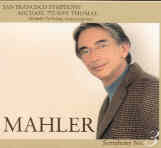Michael Tilson Thomas’ previous Mahler Third for Sony revealed no particular affinity for this music beyond adequate playing. This newcomer improves in the playing department: it’s remarkably beautiful; but if anything the conductor’s view of the music has dulled. This is a boring performance, plain and simple. The conductor seems most comfortable in the stylized second movement, where mannerism is the aesthetic point of the piece. Elsewhere, he sounds calculated rather than inspired in a work that needs a subtle hand to bind together its disparate parts, and not a micromanager intent on making every possible pit-stop along the way to the final page. Thomas often gets compared to Leonard Bernstein–falsely, because Bernstein always was ready to “let go” when the music demanded it, and Thomas almost never does. Direct comparison with Bernstein’s two recordings of this symphony show his younger colleague to be lacking in rhythmic punch, dynamic range, and a willingness to make a rough or ugly sound when necessary.
Take that wildly vulgar “storm” section in the first movement’s development: Thomas has his orchestra carefully observing dynamics and marking entrances (save for a stray snare drummer just before Figure 52), but how inhibited and polilte it all sounds next to Bernstein, or even the recent Boulez/Vienna version on DG. Similarly, it’s interesting that at 28 minutes, Bernstein (DG) is even slower than Thomas (26:31) in the finale, but Lenny takes the closing pages more quickly. Under MTT, the symphony drags to a close; Bernstein marches triumphantly. Thomas’ scherzo is even slower than Bernstein’s last recording, and those post horn episodes really take far too long despite much characterful wind playing in between. The movement dies as a result. Michelle DeYoung sounds fine in the fourth movement, but the choral fifth lacks sufficient vividness to carry the listener through the initial stages of the slow finale (again in contrast to Bernstein, who is incomparable here, particularly on Sony).
The filler, a soft-edged, slow, and studied performance of Kindertotenlieder adds nothing to the attractions of this package. DeYoung sounds merely careful, as though she’s singing through a diction lesson rather than expressing the emotion behind the words. The stereo sonics, by the way, far surpass the SACD multichannel edition, which diffuses the sound through a huge, reverberant space and robs the music-making of still more impact. The vocal items suffer particularly, with the choruses yet farther back in the mix and the orchestra in Kindertotenlieder seemingly removed to another building. In conclusion, there’s plenty of evidence here that Thomas commands exemplary control over a remarkably accomplished band, but there’s little to indicate that either he or they have much interest in surmounting the challenges offered by this most colorful and sprawling of Mahler symphonies.
































